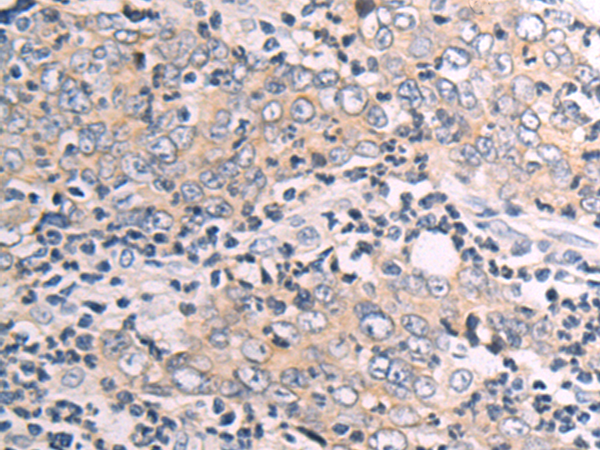
| WB | 咨询技术 | Human,Mouse,Rat |
| IF | 咨询技术 | Human,Mouse,Rat |
| IHC | 1/50-1/100 | Human,Mouse,Rat |
| ICC | 技术咨询 | Human,Mouse,Rat |
| FCM | 咨询技术 | Human,Mouse,Rat |
| Elisa | 1/5000-1/10000 | Human,Mouse,Rat |
| Aliases | V28; CCRL1; GPR13; CMKDR1; GPRV28; CMKBRL1 |
| Host/Isotype | Rabbit IgG |
| Antibody Type | Primary antibody |
| Storage | Store at 4°C short term. Aliquot and store at -20°C long term. Avoid freeze/thaw cycles. |
| Species Reactivity | Human |
| Immunogen | Synthetic peptide of human CX3CR1 |
| Formulation | Purified antibody in PBS with 0.05% sodium azide and 50% glycerol. |
+ +
以下是3篇与CX3CR1抗体相关的代表性文献(信息基于公开研究归纳):
---
1. **文献名称**: "Control of microglial neurotoxicity by the fractalkine receptor"
**作者**: Cardona AE 等
**摘要**: 该研究利用CX3CR1抗体及基因敲除小鼠,证明CX3CR1信号通过调控小胶质细胞活化参与神经退行性疾病(如阿尔茨海默病)中的神经炎症反应,抗体阻断实验表明抑制CX3CR1可减轻神经元损伤。
---
2. **文献名称**: "CX3CR1+ CD115+ CD135+ common dendritic cell precursors are the major precursors for human conventional dendritic cells"
**作者**: Hanna RN 等
**摘要**: 研究通过流式细胞术结合CX3CR1抗体,鉴定了人类树突状细胞前体亚群,发现CX3CR1高表达于特定前体细胞,并揭示其在免疫应答中的分化路径,抗体标记为细胞分选提供了关键工具。
---
3. **文献名称**: "Differential roles of CX3CR1 and CCR2 in monocyte recruitment during atherosclerosis"
**作者**: Saederup N, Charo IF
**摘要**: 通过CX3CR1抗体阻断实验及基因缺陷模型,证明CX3CR1与CCR2在单核细胞向动脉粥样硬化斑块迁移中的协同作用,抗体干预显著减少了炎性单核细胞的浸润。
---
4. **文献名称**: "CX3CR1 is required for macrophage-dependent microglial pruning in developing CNS"
**作者**: Paolicelli RC 等
**摘要**: 利用CX3CR1抗体标记及功能抑制,揭示该受体在小鼠发育期中枢神经系统突触修剪中的作用,抗体阻断导致小胶质细胞介导的突触清除功能受损。
---
注:以上文献为领域内经典研究,实际引用时建议通过PubMed或期刊官网核对完整信息。
CX3CR1 is a chemokine receptor belonging to the G protein-coupled receptor (GPCR) family, primarily binding to CX3CL1 (fractalkine). It is expressed on immune cells such as microglia, monocytes, macrophages, and dendritic cells, playing a critical role in cell migration, immune surveillance, and inflammatory responses. CX3CR1 is notably implicated in neurodegenerative diseases (e.g., Alzheimer’s), neuroinflammation, atherosclerosis, and cancer metastasis.
CX3CR1 antibodies are essential tools for detecting and studying this receptor’s expression, localization, and function. They are widely used in techniques like flow cytometry, immunohistochemistry, and Western blotting to identify CX3CR1-expressing cells in tissues or circulation. For example, anti-CX3CR1 antibodies help distinguish monocyte subsets (CX3CR1⁺ vs. CX3CR1⁻) and monitor microglial dynamics in neurological disorders. In research, these antibodies have revealed CX3CR1’s role in modulating immune cell infiltration into tissues and its dual pro- or anti-inflammatory effects depending on context.
Commercial CX3CR1 antibodies are typically validated for specificity using knockout controls. Their applications extend to preclinical models, including CX3CR1-GFP reporter mice, where antibody-based detection complements genetic tagging. Challenges remain in ensuring cross-reactivity across species and minimizing nonspecific binding. Overall, CX3CR1 antibodies are vital for dissecting immune-neural interactions and exploring therapeutic strategies targeting the CX3CL1-CX3CR1 axis.
(Word count: 200)
×